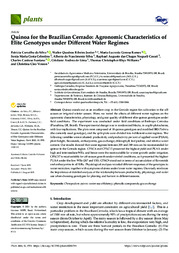Quinoa for the Brazilian Cerrado: Agronomic Characteristics of Elite Genotypes under Different Water Regimes.
Quinoa for the Brazilian Cerrado: Agronomic Characteristics of Elite Genotypes under Different Water Regimes.
Author(s): SILVA, P. C.; RIBEIRO JUNIOR, W. Q.; RAMOS, M. L. G.; CELESTINO, S. M. C.; SILVA, A. N.; CASARI, R. A. C. N.; SANTANA, C. C.; LIMA, C. A. de; WILLIAMS, T. C. R.; VINSON, C. C.
Summary: Abstract: Quinoa stands out as an excellent crop in the Cerrado region for cultivation in the offseason or irrigated winter season. Here, we tested the effects of different water regimes on the agronomic characteristics, physiology, and grain quality of different elite quinoa genotypes under field conditions. The experiment was conducted under field conditions at Embrapa Cerrados (Planaltina, DF, Brazil). The experimental design was in randomized blocks, in a split-plot scheme, with four replications. The plots were composed of 18 quinoa genotypes and modified BRS Piabiru (the currently used genotype), and the split-plots were divided into 4 different water regimes. The following variables were evaluated: productivity and productivity per unit of applied water (PUAA), plant height, flavonoids, anthocyanins, gas exchange, chlorophyll, leaf proline, and relative water content. Our results showed that water regimes between 309 and 389 mm can be recommended for quinoa in the Cerrado region. CPAC6 and CPAC13 presented the highest yield and PUAA under high and intermediate WRs, and hence were the most suitable for winter growth under irrigation. CPAC17 is most suitable for off-season growth under rainfed conditions, as it presented the highest PUAA under the low WRs (247 and 150). CPAC9 stood out in terms of accumulation of flavonoids and anthocyanins in all WRs. Physiological analyses revealed different responses of the genotypes to water restriction, together with symptoms of stress under lower water regimes. Our study reinforces the importance of detailed analyses of the relationship between productivity, physiology, and water use when choosing genotypes for planting and harvest in different seasons.
Publication year: 2021
Types of publication: Journal article
Unit: Embrapa Cerrados
Observation
Some of Embrapa's publications are published as ePub files. To read them, use or download one of the following free software options to your computer or mobile device. Android: Google Play Books; IOS: iBooks; Windows and Linux: Calibre.
Access other publications
Access the Agricultural Research Database (BDPA) to consult Embrapa's full library collection and records.
Visit Embrapa Bookstore to purchase books and other publications sold by Embrapa.

